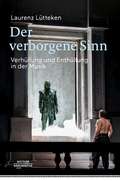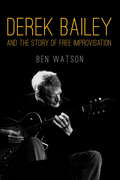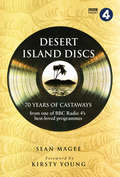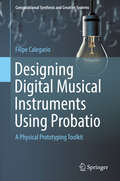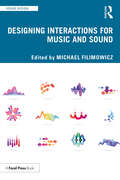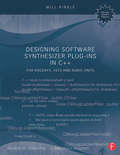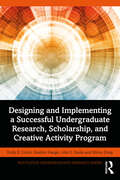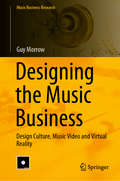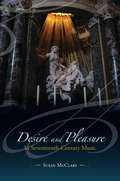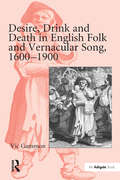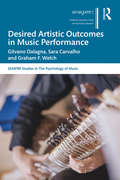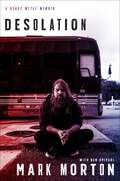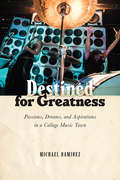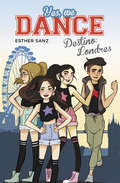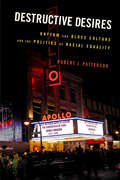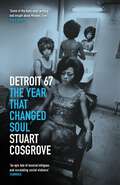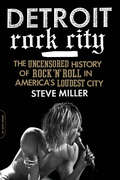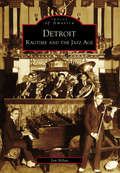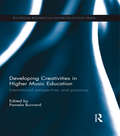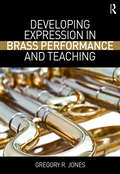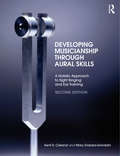- Table View
- List View
Der verborgene Sinn: Verhüllung und Enthüllung in der Musik
by Laurenz LüttekenEin Sinn, der verborgen oder enthüllt werden kann, ist eine der zentralen Denkfiguren der Neuzeit. Das betrifft auch die Frage, was Musik eigentlich sei. Je stärker man darüber nachgedacht hat, desto brüchiger, changierender ist die Annahme von einem substantiellen Wesenskern der Musik geworden. In diesem Buch geht es nicht um ästhetische oder theoretische Überlegungen dazu, sondern um die Frage, ob und auf welche Weise komponierte Musik sich selbst zum Gegenstand macht und so möglicherweise etwas von ihrem Kern preisgibt. Die optischen Metaphern von Verhüllung und Enthüllung erweisen sich dabei als ebenso hilfreich wie anschaulich. In einer Reihe von Beispielen, die vom 17. bis in die Gegenwart reichen, wird das Phänomen in seiner ganzen Vielfalt beschrieben. Dabei geht es nicht nur um Opern von Mozart bis Strauss, sondern auch um Monteverdis Vokalmusik, Haydns „Schöpfung“, die Sinfonien Bruckners oder Ligetis Etüden.
Derek Bailey and the Story of Free Improvisation
by Ben WatsonThis brilliant biography of the cult guitar player will likely cause you to abandon everything you thought you knew about jazz improvisation, post-punk and the avant-garde. Derek Bailey was at the top of his profession as a dance band and recordsession guitarist when, in the early 1960s, he began playing an uncompromisingly abstract form of music. Today his anti-idiom of "Free Improvisation" has become the lingua franca of the "avant" scene, with Pat Metheny, John Zorn, David Sylvian and Sonic Youth's Thurston Moore among his admirers.
Derrick Puffett on Music
by Kathryn Bailey Puffett'I listen to a piece and ask myself what has made the greatest impression on me. What has moved me the most about it, what has excited me the most, what it is I want to write about, what sets my mind working, what sets off my imagination.' Derrick Puffett's description to a group of Cambridge graduate students of his approach to listening and writing about music is clearly evident in the articles reprinted in this collection. For the first time, the book makes available in one place writings previously widely dispersed amongst many journals and symposia. Resonances emerge that cross from essay to essay, with the result that a larger, coherent project is revealed. Insistent on the need of music analysis to be accompanied by a wider historical knowledge, Puffett believed strongly that the methods to be adopted on each occasion must be dictated by the music at hand. His work on Bruckner, Strauss, Webern, Zemlinsky, Delius and Debussy is of enduring importance to the study of music. With a prose style distinguished for its elegance and clarity, Puffett's writings will enhance the understanding and enjoyment of the music that he discusses amongst students and teachers alike.
Desert Island Discs: 70 Years of Castaways
by Sean Magee‘For seventy years now Desert Island Discs has managed that rare feat – to be both enduring and relevant. By casting away the biggest names of the day in science, business, politics, showbiz, sport and the arts, it presents a cross-sectional snapshot of the times in which we live. As the decades have passed, the programme has kept pace; never frozen in time yet always, somehow, comfortingly the same.’ Kirsty YoungBBC Radio 4’s Desert Island Discs celebrates its seventieth birthday in 2012. Since the programme’s deviser Roy Plomley interviewed comedian Vic Oliver in January 1942, nearly 3,000 distinguished people from all walks of life have been stranded on the mythical island, accompanied by only eight records, one book and a luxury.Here the story of one of BBC Radio 4’s favourite programmes is chronicled through a special selection of castaways.Roy Plomley, inventor of the programme as well as its presenter for over forty years, quizzes the young Cliff Richard about ‘these rather frenzied movements’ the 1960s pop sensation makes on the stage. Robert Maxwell tells Plomley’s successor Michael Parkinson that ‘I will have left the world a slightly better place by having lived in it.’ Diana Mosley assures Sue Lawley that Adolf Hitler was ‘extraordinarily fascinating’ and had mesmeric blue eyes. And Johnny Vegas tugs Kirsty Young’s heart-strings with his account of a childhood so impoverished that family pets were fair game: ‘My dad had always claimed that rabbits were livestock, but we’d never eaten one before.’Desert Island Discs is much more than a radio programme. It is a unique and enduringly popular take on our lives and times – and this extensively illustrated book tells in rich detail the colourful and absorbing story of an extraordinary institution.
Desert Song
by Laekan Zea KempA family joins the music of the Texas desert night in this tale of tradition and memory from Pura Belpré Honor author Laekan Zea Kemp.It starts with a soft tapping,Uncle Eduardo drumming hishands against his dusty jeans.As the blush of sunset gives way to night in the desert, coyotes, cicadas, and barn owls emerge, each calling out to the moon. Watching from their porch, the family joins the song. One by one, each relative offers their drums, flute, maracas, strings, and voices. They sing with the insects, birds, snakes and toads; and they sing with their ancestors, an audience glittering in the stars overhead. With each strum of passed-down instruments, memories renew, and those gone are alive and near again.Desert Song hums and chimes with all the music a front porch and the desert beyond can hold. Pura Belpré Honor author Laekan Zea Kemp&’s masterfully stirring text dances through Beatriz Gutierrez Hernandez&’s enchanting and dynamic artwork. Readers will be left with the soothing sense that when creativity flourishes, the past is never out of reach, and the bonds that matter never break.Simultaneously published in Spanish as Canción del desierto.
Designing Digital Musical Instruments Using Probatio: A Physical Prototyping Toolkit (Computational Synthesis and Creative Systems)
by Filipe CalegarioThe author presents Probatio, a toolkit for building functional DMI (digital musical instruments) prototypes, artifacts in which gestural control and sound production are physically decoupled but digitally mapped. He uses the concept of instrumental inheritance, the application of gestural and/or structural components of existing instruments to generate ideas for new instruments. To support analysis and combination, he then leverages a traditional design method, the morphological chart, in which existing artifacts are split into parts, presented in a visual form and then recombined to produce new ideas. And finally he integrates the concept and the method in a concrete object, a physical prototyping toolkit for building functional DMI prototypes: Probatio. The author's evaluation of this modular system shows it reduces the time required to develop functional prototypes. The book is useful for researchers, practitioners, and graduate students in the areas of musical creativity and human-computer interaction, in particular those engaged in generating, communicating, and testing ideas in complex design spaces.
Designing Interactions for Music and Sound (Sound Design)
by Michael FilimowiczDesigning Interactions for Music and Sound presents multidisciplinary research and case studies in electronic music production, dance-composer collaboration, AI tools for live performance, multimedia works, installations in public spaces, locative media, AR/VR/MR/XR and health. As the follow-on volume to Foundations in Sound Design for Interactive Media, the authors cover key practices, technologies and concepts such as: classifications, design guidelines and taxonomies of programs, interfaces, sensors, spatialization and other means for enhancing musical expressivity; controllerism, i.e. the techniques of non-musician performers of electronic music who utilize MIDI, OSC and wireless technologies to manipulate sound in real time; artificial intelligence tools used in live club music; soundscape poetics and research creation based on audio walks, environmental attunement and embodied listening; new sound design techniques for VR/AR/MR/XR that express virtual human motion; and the use of interactive sound in health contexts, such as designing sonic interfaces for users with dementia. Collectively, the chapters illustrate the robustness and variety of contemporary interactive sound design research, creativity and its many applied contexts for students, teachers, researchers and practitioners.
Designing Software Synthesizer Plug-Ins in C++: For RackAFX, VST3, and Audio Units
by Will PirkleBridging the gap from theory to programming, Designing Software Synthesizer Plug-Ins in C++ For RackAFX, VST3 and Audio Units contains complete code for designing and implementing software synthesizers for both Windows and Mac platforms. You will learn synthesizer operation, starting with the underlying theory of each synthesizer component, and moving on to the theory of how these components combine to form fully working musical instruments that function on a variety of target digital audio workstations (DAWs). Containing some of the latest advances in theory and algorithm development, this book contains information that has never been published in textbook form, including several unique algorithms of the author’s own design. The book is broken into three parts: plug-in programming, theory and design of the central synthesizer components of oscillators, envelope generators, and filters, and the design and implementation of six complete polyphonic software synthesizer musical instruments, which can be played in real time. The instruments implement advanced concepts including a user-programmable modulation matrix. The final chapter shows you the theory and code for a suite of delay effects to augment your synthesizers, introducing you to audio effect processing. The companion website, www.focalpress.com/cw/pirkle, gives you access to free software to guide you through the application of concepts discussed in the book, and code for both Windows and Mac platforms. In addition to the software, it features bonus projects, application notes, and video tutorials. A reader forum, monitored by the author, gives you the opportunity for questions and information exchange.
Designing Software Synthesizer Plugins in C++: With Audio DSP
by Will C. PirkleDesigning Software Synthesizer Plugins in C++ provides everything you need to know to start designing and writing your own synthesizer plugins, including theory and practical examples for all of the major synthesizer building blocks, from LFOs and EGs to PCM samples and morphing wavetables, along with complete synthesizer example projects. The book and accompanying SynthLab projects include scores of C++ objects and functions that implement the synthesizer building blocks as well as six synthesizer projects, ranging from virtual analog and physical modelling to wavetable morphing and wave-sequencing that demonstrate their use. You can start using the book immediately with the SynthLab-DM product, which allows you to compile and load mini-modules that resemble modular synth components without needing to maintain the complete synth project code. The C++ objects all run in a stand-alone mode, so you can incorporate them into your current projects or whip up a quick experiment. All six synth projects are fully documented, from the tiny SynthClock to the SynthEngine objects, allowing you to get the most from the book while working at a level that you feel comfortable with. This book is intended for music technology and engineering students, along with DIY audio programmers and anyone wanting to understand how synthesizers may be implemented in C++.
Designing and Implementing a Successful Undergraduate Research, Scholarship and Creative Activity Program (Routledge Undergraduate Research Series)
by John Banks Holly Unruh Heather Haeger Winny DongDesigning and Implementing a Successful Undergraduate Research, Scholarship and Creative Activity Program is designed as a resource for faculty, administrators, and university leaders interested in developing new, or expanding existing, undergraduate research programs. The book provides a practical handbook addressing the many "how to" questions associated with running a successful undergraduate research enterprise – ranging from how to organize an undergraduate research office, to how to find funding, foster cross-campus relationships, and develop learning outcomes for students in order to maximize the benefits of the research experience. It also addresses best practices in mentoring, how faculty mentorship fits within the discussion of tenure and promotion, and the basics of assessment, for both funder reporting and program improvement.Containing a series of vignettes offering specific advice from program directors, faculty mentors, and university administrators from a diverse array of universities and colleges, this book showcases their hands-on tips, advice, and lessons learned. Addressing key issues through real-world experience, the authors show how to build effective cross-disciplinary undergraduate research programs with positive impacts for students and faculty.
Designing the Music Business: Design Culture, Music Video and Virtual Reality (Music Business Research)
by Guy MorrowThis book addresses the neglect of visual creativities and content, and how these are commercialised in the music industries. While musical and visual creativities drive growth, there is a lack of literature relating to the visual side of the music business, which is significant given that the production of meaning and value within this business occurs across a number of textual sites.Popular music is a multimedia, discursive, fluid, and expansive cultural form that, in addition to the music itself, includes album covers; gig and tour posters; music videos; set, stage, and lighting designs; live concert footage; websites; virtual reality/augmented reality technologies; merchandise designs; and other forms of visual content. As a result, it has become impossible to understand the meaning and value of music without considering its relation to these visual components and to the interrelationships between them. Using design culture theory, participant observation, interviews, case studies, and a visual methodology to explore the topic, this research-based book is a valuable study aid for undergraduate and postgraduate students of subjects including the music business, design, arts management, creative and cultural industries studies, business and management studies, and media and communications.
Desire and Pleasure in Seventeenth-Century Music
by Susan McclaryIn this book, Susan McClary examines the mechanisms through which seventeenth-century musicians simulated extreme affective states--desire, divine rapture, and ecstatic pleasure. She demonstrates how every major genre of the period, from opera to religious music to instrumental pieces based on dances, was part of this striving for heightened passions by performers and listeners. While she analyzes the social and historical reasons for the high value placed on expressive intensity in both secular and sacred music, and she also links desire and pleasure to the many technical innovations of the period. McClary shows how musicians--whether working within the contexts of the Reformation or Counter-Reformation, Absolutists courts or commercial enterprises in Venice--were able to manipulate known procedures to produce radically new ways of experiencing time and the Self.
Desire, Drink and Death in English Folk and Vernacular Song, 1600-1900
by Vic GammonThis much-needed book provides valuable insights into themes and genres in popular song in the period c. 1600-1900. In particular it is a study of popular ballads as they appeared on printed sheets and as they were recorded by folk song collectors. Vic Gammon displays his interest in the way song articulates aspects of popular mentality and he relates the discourse of the songs to social history. Gammon discusses the themes and narratives that run through genres of song material and how these are repeated and reworked through time. He argues that in spite of important social and economic changes, the period 1600-1850 had a significant cultural consistency and characteristic forms of popular musical and cultural expression. These only changed radically under the impact of industrialization and urbanization in the nineteenth century. The book will appeal to those interested in folk song, historical popular music (including church music), ballad literature, popular literature, popular culture, social history, anthropology and sociology.
Desired Artistic Outcomes in Music Performance (SEMPRE Studies in The Psychology of Music)
by Graham F. Welch Gilvano Dalagna Sara CarvalhoDesired Artistic Outcomes in Music Performance is about empowering musicians to achieve their professional and personal goals in music. The narrative argues that developing musicians should be supported in conceptualizing and achieving their desired artistic outcomes (DAO), as these have been recognized as key elements in a successful career transition in and beyond their studies in higher education. The text explores the nature of DAO and illustrates how higher education students can be enabled to explore and develop these. The book draws on the findings from a range of exploratory studies which: Bring to light connections between contemporary topics in music, such as artistic research and career development; Contribute to existing discussions on innovative pedagogical approaches in higher education in music; and Offer theoretical models to support the broad artistic and professional development in young musicians. This is a text grounded in theory and practice, and which draws on case study examples, as well as historical perspectives and coverage of contemporary issues regarding employment in the music industries. The book will be of particular interest to aspiring music professionals and all those working in the areas of Music Education, Performance Studies and Artistic Research.
Desolation: A Heavy Metal Memoir
by Mark MortonA gritty, revealing heavy metal memoir by Lamb of God&’s guitarist and lyricist, Mark Morton, which explores both his life in music and his tumultuous path through addiction and into recovery
Destined for Greatness: Passions, Dreams, and Aspirations in a College Music Town
by Michael RamirezPursuing the dream of a musical vocation—particularly in rock music—is typically regarded as an adolescent pipedream. Music is marked as an appropriate leisure activity, but one that should be discarded upon entering adulthood. How then do many men and women aspire to forge careers in music upon entering adulthood? In Destined for Greatness, sociologist Michael Ramirez examines the lives of forty-eight independent rock musicians who seek out such non-normative choices in a college town renowned for its music scene. He explores the rich life course trajectories of women and men to explore the extent to which pathways are structured to allow some, but not all, individuals to fashion careers in music worlds. Ramirez suggests a more nuanced understanding of factors that enable the pursuit of musical livelihoods well into adulthood.
Destino: Londres (Serie Yes, we dance #Volumen 2)
by Esther Sanz¡Acompaña a Martina, Sofía, Liu y Violeta en esta nueva aventura en el corazón de Londres! Martina y sus amigas viajan hasta la capital inglesa para participar en el maratón de baile que va a celebrarse en el Hyde Park. El grupo que salga ganador de esta competición será el que aparecerá en el nuevo videoclip del grupo del momento, los BB Brothers. No será nada fácil, pero las chicas lo tienen claro... ¡Están dispuestas a darlo todo!
Destructive Desires: Rhythm and Blues Culture and the Politics of Racial Equality
by Robert J. PattersonDespite rhythm and blues culture’s undeniable role in molding, reflecting, and reshaping black cultural production, consciousness, and politics, it has yet to receive the serious scholarly examination it deserves. Destructive Desires corrects this omission by analyzing how post-Civil Rights era rhythm and blues culture articulates competing and conflicting political, social, familial, and economic desires within and for African American communities. As an important form of black cultural production, rhythm and blues music helps us to understand black political and cultural desires and longings in light of neo-liberalism’s increased codification in America’s racial politics and policies since the 1970s. Robert J. Patterson provides a thorough analysis of four artists—Kenneth “Babyface” Edmonds, Adina Howard, Whitney Houston, and Toni Braxton—to examine black cultural longings by demonstrating how our reading of specific moments in their lives, careers, and performances serve as metacommentaries for broader issues in black culture and politics.
Detroit 67: The Year That Changed Soul (The Soul Trilogy #1)
by Stuart CosgroveFirst in the award-winning soul music trilogy—featuring Motown artists Diana Ross & the Supremes, Smokey Robinson, Marvin Gaye, and others. Detroit 67 is &“a dramatic account of twelve remarkable months in the Motor City&” during the year that changed everything (Sunday Mail). It takes you on a turbulent journey through the drama and chaos that ripped through the city in 1967 and tore it apart in personal, political, and interracial disputes. It is the story of Motown, the breakup of the Supremes, and the damaging clashes at the heart of the most successful African American music label ever. Set against a backdrop of urban riots, escalating war in Vietnam, and police corruption, the book weaves its way through a year when soul music came of age and the underground counterculture flourished. LSD arrived in the city with hallucinogenic power, and local guitar band MC5—self-styled holy barbarians of rock—went to war with mainstream America. A summer of street-level rebellion turned Detroit into one of the most notorious cities on earth, known for its unique creativity, its unpredictability, and self-lacerating crime rates. The year 1967 ended in social meltdown, rancor, and intense legal warfare as the complex threads that held Detroit together finally unraveled. &“A whole-hearted evocation of people and places,&” Detroit 67 is &“a tale set at a fulcrum of American social and cultural history&” (Independent).
Detroit Country Music: Mountaineers, Cowboys, And Rockabillies
by Craig Maki Keith CadyThe richness of Detroit’s music history has by now been well established. We know all about Motown, the MC5, and Iggy and the Stooges. We also know about the important part the Motor City has played in the history of jazz. But there are stories about the music of Detroit that remain untold. One of the lesser known but nonetheless fascinating histories is contained within Detroit’s country music roots. At last, Craig Maki and Keith Cady bring to light Detroit’s most important country and western and bluegrass stars, such as Chief Redbird, the York Brothers, and Roy Hall. Beyond the individuals, Maki and Cady also map out the labels, radio programs, and performance venues that sustained Detroit’s vibrant country and bluegrass music scene. In the process, Detroit Country Music examines how and why the city’s growth in the early twentieth century, particularly the southern migration tied to the auto industry, led to this vibrant roots music scene. This is the first book—the first resource of any kind—to tell the story of Detroit’s contributions to country music. Craig Maki and Keith Cady have spent two decades collecting music and images, and visiting veteran musicians to amass more than seventy interviews about country music in Detroit. Just as astounding as the book’s revelations are the photographs, most of which have never been published before. Detroit Country Music will be essential reading for music historians, record collectors, roots music fans, and Detroit music aficionados.
Detroit Rock City: The Uncensored History of Rock 'n' Roll in America's Loudest City
by Steve MillerDetroit Rock City is an oral history of Detroit and its music told by the people who were on the stage, in the clubs, the practice rooms, studios, and in the audience, blasting the music out and soaking it up, in every scene from 1967 to today.From fabled axe men like Ted Nugent, Dick Wagner, and James Williamson jump to Jack White, to pop flashes Suzi Quatro and Andrew W.K., to proto punkers Brother Wayne Kramer and Iggy Pop, Detroit slices the rest of the land with way more than its share of the Rock Pie.Detroit Rock City is the story that has never before been sprung, a frenzied and schooled account of both past and present, calling in the halcyon days of the Grande Ballroom and the Eastown Theater, where national acts who came thru were made to stand and deliver in the face of the always hard hitting local support acts. It moves on to the Michigan Palace, Bookies Club 870, City Club, Gold Dollar, and Magic Stick - all magical venues in America's top rock city.Detroit Rock City brings these worlds to life all from the guys and dolls who picked up a Strat and jammed it into our collective craniums. From those behind the scenes cats who promoted, cajoled, lost their shirts, and popped the platters to the punters who drove from everywhere, this is the book that gives life to Detroit's legend of loud.
Detroit: Ragtime and the Jazz Age
by Jon MilanDetroit has always been at the forefront of American popular music development, and the ragtime years and jazz age are no exception. The city's long history of diversity has served the region well, providing a fertile environment for creating and nurturing some of America's most distinctly indigenous music. With a focus on the people and places that made Detroit a major contributor to America's rich musical heritage, Detroit: Ragtime and the Jazz Age provides a unique photo journal of a period stretching from the Civil War to the diminishing years of the big bands in the early 1940s.
Developing Creativities in Higher Music Education: International Perspectives and Practices (Routledge Research in Higher Education)
by Pamela BurnardThis is the first book to critically address the issue of how we can enhance and develop creativities in higher music education. It features new international, richly diverse perspectives on the nature and practice of creativities in different cultural and institutional contexts, in varying roles and in response to diverse professional pressures and expectations of artistic and educational achievement. This compelling and provocative book combines powerful social and educational commentaries and examples drawn from international sources based on original practices and experience of a diversity of creativities. The authors provide an important contribution by drawing attention to what is at the heart of all music and how we can understand and foster these multiple creativities at an individual and institutional level. It features new analyses of the question of creativities in higher music education, and offers illustrative and innovative examples of adaptive learning environments for teaching and learning creatively, considering the broader issue of the role of creativities in relation to educational policy in the context of increasingly interventionist governments and rapidly paced educational change. Topics covered include: -the conceptual tools for people to think about and debate multiple creativities -the role of creativities in higher music education-how musicians can develop multiple creativities in new ways -new approaches to teaching and learning for multiple creativities -what constitute leadership creativities in conservatoires and music departments-creativities at the interface of institutional learning cultures-assessing the multiple creativities of music. Developing Creativities in Higher Music Education offers a multi-disciplinary research and practice focus, which will be essential reading for anyone involved in higher education and industry sectors. The book will appeal to academics and practitioners in music, researchers, instrumental and vocal teachers, curriculum and policy developers and institutional managers who want to enrich the higher education experiences of their students and enable them to develop more of their creative potential. It is also ideal reading for undergraduate and postgraduate students of music education who are looking for an authoritative selection of writings that define the fields of musical creativities in one comprehensive volume.
Developing Expression in Brass Performance and Teaching
by Gregory R. JonesDeveloping Expression in Brass Performance and Teaching helps university music teachers, high school band directors, private teachers, and students develop a vibrant and flexible approach to brass teaching and performance that keeps musical expression central to the learning process. Strategies for teaching both group and applied lessons will help instructors develop more expressive use of articulation, flexibility in sound production, and how to play with better intonation. The author shares strategies from today’s best brass instrument performers and teachers for developing creativity and making musical expression central to practicing and performing. These concepts presented are taken from over thirty years of experience with musicians like Wynton Marsalis, Barbara Butler, Charles Geyer, Donald Hunsberger, Leonard Candelaria, John Haynie, Bryan Goff, members of the Chicago Symphony and New York Philharmonic and from leading music schools such as the Eastman School of Music, The University of North Texas and The Florida State University.? The combination of philosophy, pedagogy, and common sense methods for learning will ignite both musicians and budding musicians to inspired teaching and playing.
Developing Musicianship Through Aural Skills: A Holistic Approach to Sight Singing and Ear Training
by Kent D. Cleland Mary Dobrea-GrindahlDeveloping Musicianship through Aural Skills, Second Edition, is a comprehensive method for learning to hear, sing, understand, and use the foundations of music as part of an integrated curriculum, incorporating both sight singing and ear training in one volume. Under the umbrella of musicianship, this textbook guides students to "hear what they see, and see what they hear," with a trained, discerning ear on both a musical and an aesthetic level. Key features of this new edition include: Revised organization, with exercises gradually progressing from the simple to more difficult, taking beginner students’ varied skill sets into account. An enhanced companion website, with interactive training modules for students to practice core skills, and additional exercises, dictation lesson plans and worksheets for instructors Enhanced coverage and a specific methodology for covering post-tonal material Greater emphasis on developing improvisation skills and realizing lead sheets The text reinforces both musicianship and theory in a systematic method, and its holistic approach provides students the skills necessary to incorporate professionalism, creativity, confidence, and performance preparation in their music education. The second edition of Developing Musicianship through Aural Skills provides a strong foundation for undergraduate music students and answers the need for combining skills in a more holistic, integrated music theory core.
